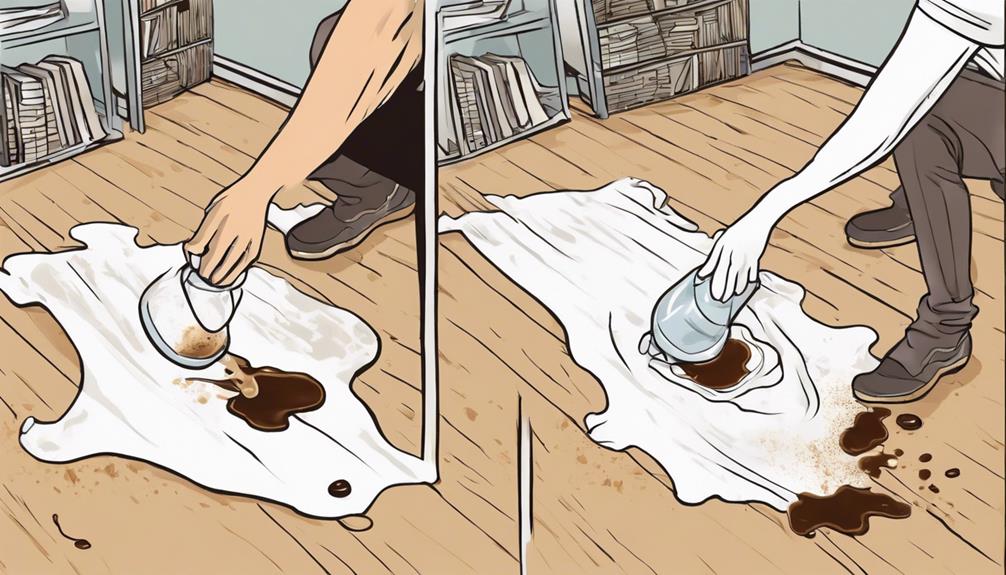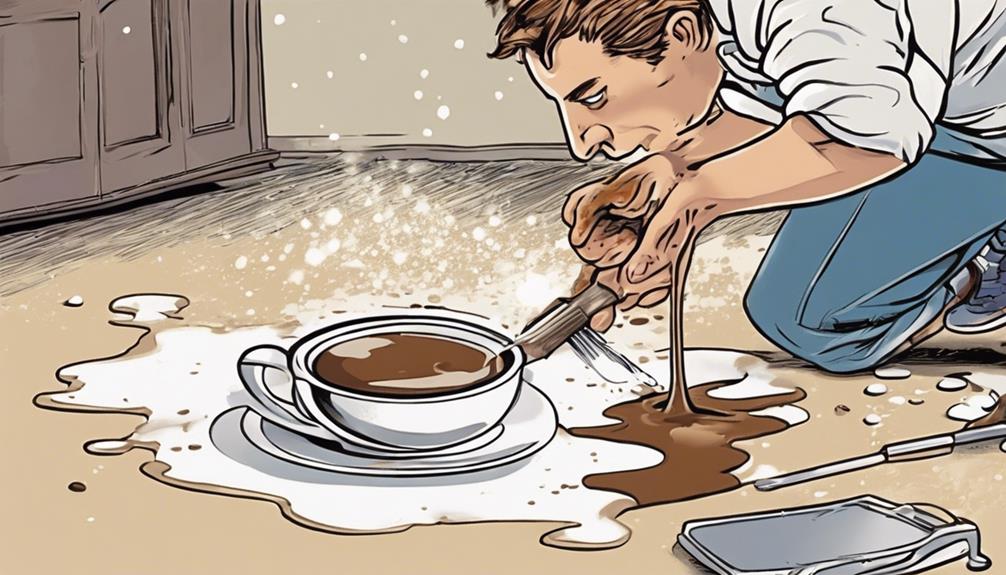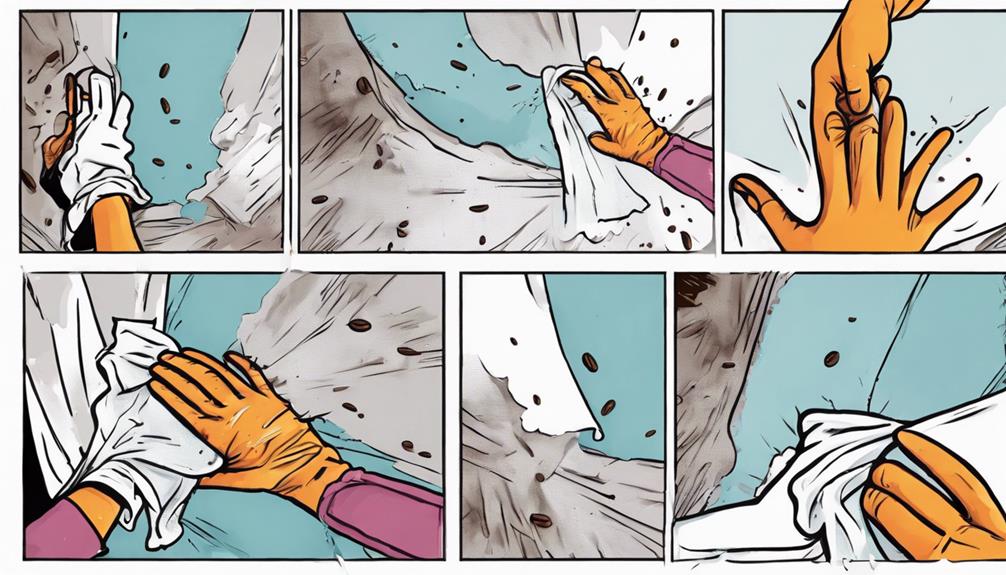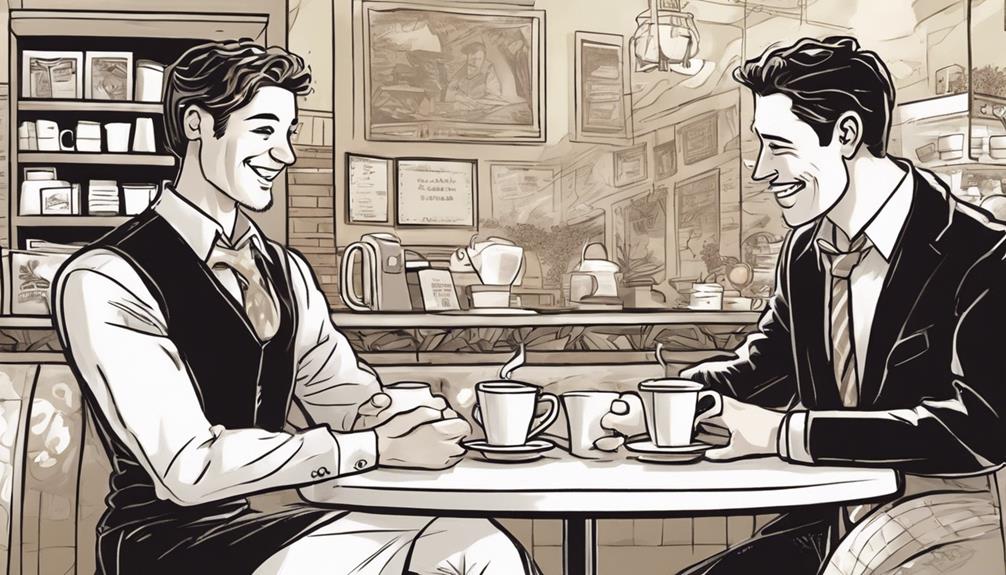Remove coffee stains effectively by soaking fabric in hot water with white vinegar and washing soda. For carpets without cream or sugar, blot with neutral detergent and apply vinegar and baking soda. With cream or sugar, scrape off excess and use a carpet cleaner. Hard surfaces? Gently scrub a mix of detergent and water. Walls and ceilings need warm soapy water promptly. Stubborn stains? Make a paste with baking soda, scrub, then rinse thoroughly. Want more solutions? More tips await!
Key Takeaways
- Avoid using bleach on coffee stains, as it can set the stain.
- Use enzyme-based laundry detergents for fabric stains.
- Try soaking in hot water with washing soda and vinegar.
- Use neutral detergent and white vinegar on hard surfaces.
- For stubborn stains, create a paste with baking soda and water.
Fabric and Apparel Stain Removal
To effectively eliminate coffee stains from fabric and apparel, consider using enzyme-containing laundry detergents for pre-treatment.
If you're dealing with a persistent coffee stain on your favorite shirt, start by soaking the affected area in hot water mixed with a bit of washing soda. This solution can help loosen the stain before washing. For an extra boost, add a splash of white vinegar to the mix. White vinegar is known for its stain-fighting properties and can help break down the coffee residue on the fabric.
After pre-treating the stain, wash the garment as usual with your regular laundry detergent. Make sure to check the care label first to confirm the garment can handle the washing instructions.
Once the garment is clean, inspect it carefully to see if the coffee stain has disappeared. If needed, you can repeat the pre-treatment process or try other stain removal methods for a spotless finish.
Carpet Stain Removal (Without Cream/Sugar)

For effective removal of coffee stains from carpets (without cream/sugar), start by blotting excess liquid and then proceed with a cleaning solution of neutral detergent and lukewarm water. Absorb as much of the spill as possible using a clean cloth or paper towel.
Mix a solution of neutral detergent with lukewarm water and apply it to the stained area, gently working it into the carpet fibers. If the stain persists, consider using a mixture of white household vinegar and water to help break down the residue.
In cases where the coffee stain is particularly stubborn, baking soda can be sprinkled over the affected area to absorb excess moisture and help lift the stain. Remember to test any cleaning agents on a small, inconspicuous area of the carpet first to guarantee they won't cause damage.
For tea stains, a similar approach can be taken using the same cleaning solutions and techniques outlined above. Gently blot and repeat the cleaning process until the coffee or tea stain is effectively removed from the carpet fibers.
Carpet Stain Removal (With Cream/Sugar)

Gently scrape away any surplus soil from the coffee blemish on the carpet where cream and sugar have been spilled. Next, sponge the stained area with a commercial carpet cleaner to help elevate the blemish. Then, use a neutral detergent solution on the carpet pile to further eliminate the coffee blemish. Remember to pretest any cleaning agents on a concealed area of the carpet to confirm colorfastness. After treating the blemish, properly rinse the area with warm water and a damp cloth, ensuring all cleaning agents are eradicated. Allow the treated area to dry completely for efficient stain removal.
| Steps to Remove Coffee Blemish with Cream/Sugar |
|---|
| 1. Gently scrape surplus soil from the blemish. |
| 2. Sponge area with a carpet cleaner. |
| 3. Apply neutral detergent solution on pile. |
Hard Surface Floor Stain Removal

Mix a solution of Washing Soda or laundry detergent with water to effectively address coffee stains on hard surface floors.
Use a soft bristle brush to gently scrub the stained area with the cleaning solution.
It's essential to always follow the directions and cautions on the container of the cleaning solution to prevent damage to the floor.
Ensure proper ventilation when using cleaning solutions to avoid inhaling harmful fumes.
Promptly blot up any excess spill and thoroughly rinse and dry the floor after cleaning to prevent residue buildup.
By taking these steps, you can effectively remove coffee stains from hard surface floors without causing any harm.
Wall and Ceiling Stain Removal

When tackling wall and ceiling coffee stains, remember to promptly blot or sponge up the spill to prevent further absorption.
Use warm sudsy water or a mild detergent solution for cleaning the affected area, and consider using baking soda for older stains.
For stubborn stains, a mixture of ammonia and hydrogen peroxide may be necessary for effective removal.
Surface Preparation Tips
To effectively prepare surfaces for stain removal on walls and ceilings, promptly blot or sponge up any excess coffee spill to prevent further absorption.
Cleaning the affected area with warm sudsy water or a mild detergent solution will help remove surface coffee stains.
For older or stubborn coffee stains, sprinkle baking soda directly on the stain and gently scrub with a soft brush. Remember to rinse the area thoroughly with clean water after cleaning to remove any residue and prevent leaving a soapy film behind.
In cases where tough coffee stains persist, you can create a solution using equal parts of ammonia and hydrogen peroxide to spot treat the affected area. After applying the solution, rinse the area again and make sure it dries completely.
Stubborn Stain Removal
Promptly address persistent coffee stains on walls and ceilings by utilizing effective cleaning techniques and targeted solutions for thorough stain removal. When dealing with these tough stains, start by blotting or sponging up any excess coffee to prevent further spreading.
Then, clean the affected areas with warm sudsy water or a mild detergent solution to help lift the stain from the surface.
For older or unyielding coffee stains that are proving resistant, sprinkle baking soda on the affected area and gently scrub with a sponge. This abrasive action can aid in breaking down the stain for easier removal. Remember to rinse the walls or ceilings thoroughly with clean water after cleaning to make certain all residue is eliminated.
If the stain still persists, try creating a mixture of ammonia and hydrogen peroxide to tackle the tough coffee stains head-on. This powerful combination can help break down and lift even the most persistent of stains, leaving your walls and ceilings looking fresh and clean.
Wood Furniture Stain Removal

Think about mixing a solution of equal parts chlorine bleach and water or using a wood-safe oxygen bleach for effective removal of coffee stains from wood furniture. Before applying the solution, it's essential to test it on a hidden area of the furniture to confirm compatibility.
Once verified, apply the bleach solution to the coffee stain using a soft cloth, gently rubbing in a circular motion until the stain lifts. Afterward, rinse the area with water and thoroughly dry it with a clean cloth to prevent any damage to the wood. For a more natural approach, consider using coffee grounds in gardening. You can sprinkle used coffee grounds around the base of acid-loving plants such as azaleas, hydrangeas, and blueberries to give them a nutrient boost. Additionally, coffee grounds can also help repel pests such as slugs and snails in your garden.
To restore the wood furniture's original appearance and protect it from future stains, you may want to ponder refinishing or resealing it after removing the coffee stain. This additional step can help maintain the beauty and integrity of your furniture for years to come.
Remember to always follow safety precautions when working with bleach and ensure proper ventilation in the area where you're cleaning the stained wood furniture.
Marble Surface Stain Removal

When dealing with coffee stains on marble surfaces, you can create a gentle paste using baking soda and water to remove the stain effectively.
Remember to steer clear of acidic or abrasive cleaners that could harm the marble surface.
Consider testing any cleaning solution on a small area first to guarantee it won't cause damage.
Marble Cleaning Techniques
To effectively remove coffee stains from marble surfaces, create a paste with baking soda and water. Gently scrub the paste into the stain, allowing it to sit for an hour before wiping it away with a damp cloth.
For more stubborn coffee stains on marble, mix ammonia and hydrogen peroxide to form a potent cleaning solution. Apply the ammonia and hydrogen peroxide mixture to the stain, let it sit for 24 hours, then rinse thoroughly with water.
Removing Stubborn Stains
If dealing with stubborn coffee stains on your marble surfaces, start by gently blotting up any excess spill without spreading the stain further. Avoid rubbing the stain into the marble.
Create a paste using baking soda and water, then gently scrub the coffee stain. Thoroughly rinse the area with warm water and make sure it's dried to prevent residue.
For more persistent stains, mix ammonia and hydrogen peroxide to form a cleaning solution for marble surfaces. Always test any cleaning solution on a small, hidden area of the marble before applying it to the stain to prevent damage.
Other Surface Stain Removal

Explore various effective methods for removing stains from surfaces other than fabrics. When dealing with different surfaces like walls, wood, alabaster, or ceramic and glass, selecting the appropriate approach is crucial in addressing coffee stains effectively. Here are some tips to assist you with other surface stain removal:
- Walls and Ceilings: Clean spills promptly with warm soapy water to prevent coffee stains from setting in.
- Wood Surfaces: Utilize a mixture of baking soda and water to eliminate old coffee stains effectively.
- Alabaster Surfaces: Wash with warm water and apply a solution of ammonia and hydrogen peroxide for persistent coffee stains.
- Ceramic and Glass Surfaces: Blot excess spill, clean with warm soapy water, and utilize ammonia and hydrogen peroxide for challenging coffee stains.
Remember to always rinse well and dry surfaces thoroughly after treating coffee stains to avoid further damage or discoloration.
Frequently Asked Questions
Can You Remove Coffee Stains With Bleach?
Yes, you can remove coffee stains with bleach. Be cautious as chlorine bleach may harm certain fabrics. For colored items or delicate materials, consider oxygen or sodium perborate bleach. Always check the care label first and dilute bleach as directed.
What Is the Best Stain Remover for Coffee Stains?
Looking to tackle coffee stains? Oxygen bleach like sodium perborate is a gentle choice for colored fabrics, avoiding discoloration. Enzyme-containing detergents work wonders on washable items to break down stains organically. Remember to check care labels first!
What Is the Best Way to Get Coffee Stains Out of Clothes?
To get coffee stains out of clothes, pre-treat by soaking in water and vinegar, then apply a stain remover or water with dish soap. Use chlorine or oxygen bleach for tough stains (if safe for fabric), and enzyme detergent for delicate items. Check care labels first. After treating the stain, wash the clothes as usual and air dry. For an extra boost, save used coffee grounds for gardening. They can be sprinkled around plants to act as a natural fertilizer and pest deterrent. This sustainable practice not only helps save the environment by reducing waste, but also promotes healthy and thriving gardens.
Does Coffee Come Out With Bleach?
Yes, coffee stains can be removed with bleach, but caution is necessary. Use chlorine bleach for white fabrics, and oxygen bleach for colored or delicate materials. Always check the care label, dilute bleach, test on a small area, rinse thoroughly, and follow care instructions.
Conclusion
Now that you have the tools and knowledge to tackle those stubborn coffee stains, go forth and conquer!
Remember, like a ray of sunshine breaking through the clouds, you can bring new life to your fabrics, carpets, and surfaces.
Don't let those pesky stains bring you down – with a little bleach and elbow grease, you can make them disappear in no time.
Happy cleaning!








